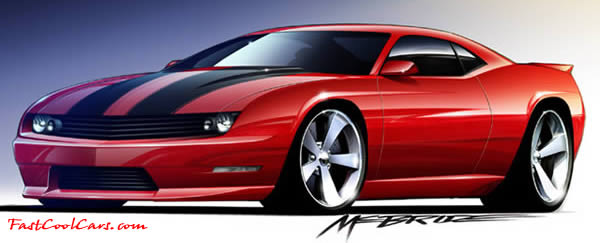|
Chevrolet withstood a titanic amount of grief, suffering the slings and
arrows of the Camaro faithful (as well as many in the enthusiast press)
when it torpedoed the 35-year-old pony car in 2002. After years of keeping
the Camaro afloat despite foundering sales, Chevy felt it needed to cut
the storied but antiquated F-body loose.
The besieged automaker went on to suffer the added scourge of watching
Ford Mustang sales—buoyed by that car’s first complete redesign since
1979—swell to fill the void. For Chevrolet and its fans, this took some of
the luster off their best news for 2005: Chevy outsold the Ford brand for
the first time in 19 years.
Now the folks at Chevrolet have finally given Camaro loyalists something
to celebrate. Perhaps inspired by the Mustang’s success, or even the
booming interest in classic American muscle, the Bow-tie bunch has deemed
conditions again conducive to a resuscitation of its pony car. And while
the Camaro exists solely in concept form for now, we expect a production
version to follow, by 2009 at the latest. (Those who think that’s too long
should consider that even mighty Toyota took three years to turn the FJ
Cruiser concept into a production model.)
|
|
GM Unveils Concept Camaro In Los Angeles
PHR Makes it to the L.A. Auto Show
The PHR team was cruising the L.A. Auto Show on Monday and happened to be
there just in time to catch the West Coast unveiling of the new Camaro
concept car from GM. Aggressive modern design is mixed with a few styling
cues from the past, so there is no doubt of this ride's heritage. This
modern bruiser is packed with the performance that has made the Camaro
nameplate synonymous with "musclecar." Don't run down to the GM dealership
with your checkbook just yet, this is just a concept and the real deal is
still a couple years out. With the new Mustang selling like hotcakes and
the recent unveiling of the new two-door Dodge Challenger, the Camaro
makes it just like old times again, except faster.
Under the car’s bulging hood sits a Corvette-derived 6.0-liter LS2 V8,
tuned to crank out 400 hp and anchored to a Tremec T56 six-speed manual
transmission. The engine also makes use of cylinder-deactivation
technology to increase fuel efficiency. Chevy expects the Camaro to
achieve 30 mpg on the freeway.
Handling duties fall to a four-wheel independent suspension, with
MacPherson struts up front, a multilink design in back and
progressive-rate coil springs and gas-pressurized dampers all around. It’s
basically a derivative of the General’s Australian-built (and briefly
canceled for export here from Down Under) Zeta rear-drive platform, which
we expect will underpin a future Pontiac GTO as well as other U.S.-bound
GM vehicles.
The show car sits on a set of flashy concept-specific wheels, 21-inch
alloys up front wrapped in 245/30 rubber, with 305/30R-22s putting the
power down in back. All four wheels house four-piston calipers gripping
14-inch vented disc brakes.
There is more than a hint of 1969 Camaro in the car’s lines, especially
along its beltline and in the grille. The echoes come as little surprise,
and not only because many consider the ’69 model the best-looking of the
first-generation car. Ask Ed Welburn, GM vice president and design chief,
what sits in his personal garage, and the first car he mentions is his
yellow and black ’69 SS.
“I wanted to capture the spirit, the essence of [the ’69 Camaro,” says
Tom Peters, director of design for GM’s global rear-wheel-drive
performance cars. “But I am not a proponent of ‘retro’ design.” A barb
aimed at Mustang? Probably.
Peters says he was more interested in distilling the essence of the ’69
car and infusing that into the concept.
“What are the powerful, passion-filled cues that made it desirable back
then, make it exciting and desirable today, and I bet you a donut in 20 or
40 years will also be pretty neat to look at?” Peters says he asked of his
design team. “I want you to sketch the meanest street-fighting dog you can
sketch.”
Between its low, wide stance, flared fenders and prominent grille, the
Camaro indeed has the presence of a street fighter. And it looks every bit
the successor to the ’69 without being a complete rehash.
Peters admits he also took the liberty of sprinkling the car with a few
Corvette cues; understandable, given he was the chief designer of the C6.
Much of the Vette’s contribution lies in the Camaro’s rear, wrapping
around to the quarter-panels.
“Times have changed. Obviously there are different customer expectations,
there are more competitors out there, there are technical advances that
all had to be factored into not only the design but the function as well,”
he explains. “The function drives the aesthetic in a way.”
If the Camaro drives as well as it looks, then GM may have a winner on its
hands. And with Dodge showing a Challenger just down the hall, it seems
we may have an old-fashioned, pony-car competition.
|
























